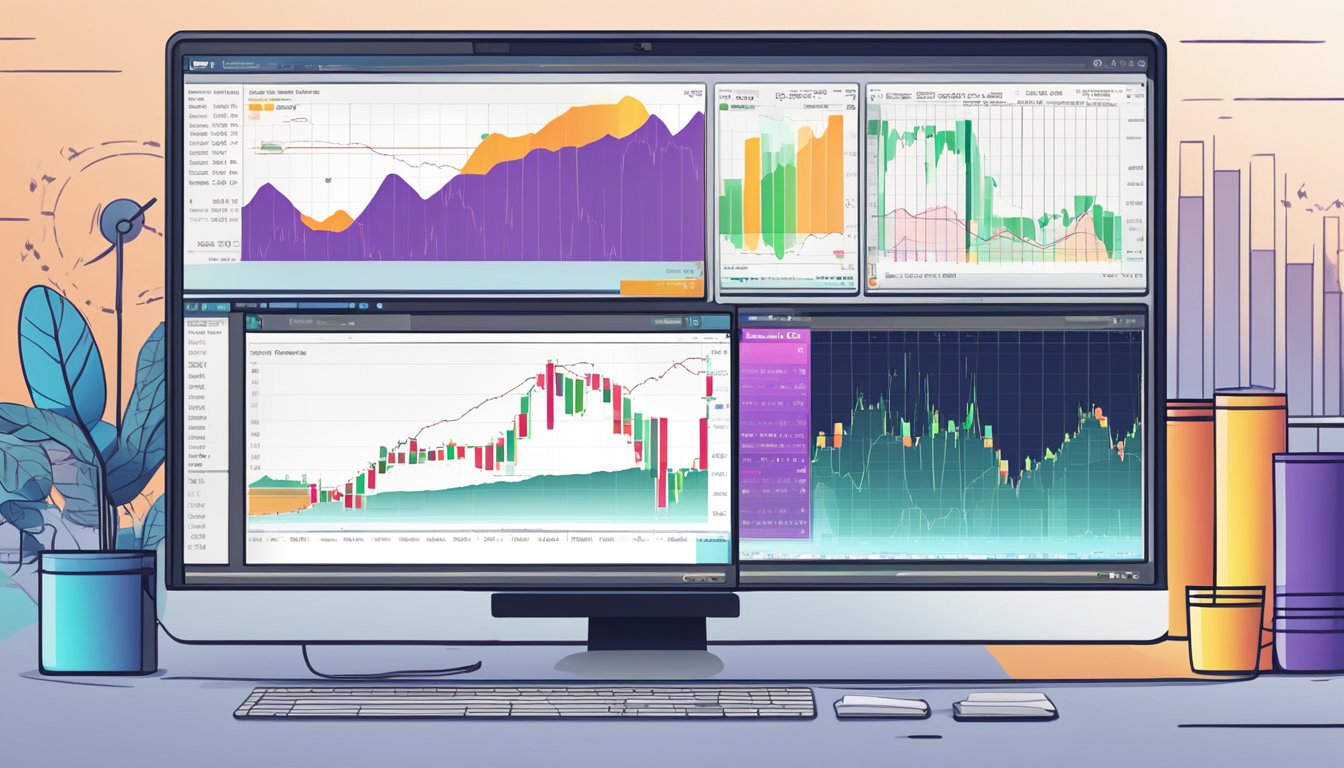
Margin Trading gives investors the much-needed power to amplify the buying potential to their advantage. It allows traders to borrow money from their broker so that they can invest in much larger positions than they could manage with just their own capital. By using margin, I can increase my buying power, which can lead to greater returns if my investments perform well. However, the flip side is that it also comes with increased risks, potentially resulting in significant losses.
Understanding how margin trading works is essential for anyone considering this strategy. The key concepts include the initial margin, maintenance margin, and the potential for a margin call. These terms define how much I need to deposit to open a position and what happens if the value of my investments falls below a certain level. Knowing these rules helps me to manage my risks better and make informed investment decisions.
As I explore the dynamics of margin trading, I will delve into the strategies I can use, as well as the costs involved with borrowing. By planning carefully and being aware of the risks, I can utilize margin trading to enhance my investment approach effectively.
Key Takeaways
- Margin trading can amplify potential investment returns but also increases risk.
- Understanding key terms like margin call and maintenance margin is crucial.
- Careful planning is required to manage risks and costs effectively when trading on margin.
Understanding Margin Trading

Margin trading allows investors to borrow money to trade securities, amplifying both potential gains and risks. Key aspects include margin accounts, the use of leverage, and the role of brokerage firms in facilitating margin trades.
The Basics of Margin Accounts
A margin account is a special type of brokerage account that enables me to borrow money from my broker to purchase securities. With a margin account, I can buy more stock than I could with just my cash. The initial margin requirement typically allows me to borrow up to 50% of the purchase price of a stock. This means if I want to buy $10,000 worth of stock, I need to provide at least $5,000 in my account as collateral.
The Financial Industry Regulatory Authority (FINRA) oversees margin trading rules. They set minimum margin requirements, but brokerage firms can establish their own policies. It’s important to understand the maintenance margin, which is the minimum equity I must maintain in my account to avoid a margin call. If my account’s value drops below this level, I may need to deposit more cash or sell securities to cover the difference.
Leveraging Investments
Leverage is a powerful tool in margin trading. By borrowing funds, I can increase my purchasing power, which can potentially magnify profits. For instance, if my stock investment rises, my returns could significantly exceed my initial investment. However, the risk is equally heightened. If the stock price declines, losses can escalate quickly, leading to a situation where I’m forced to repay borrowed funds regardless of my investment’s performance.
When I trade on margin, I need to keep in mind the interest charges that apply to the borrowed funds. Stock prices and market conditions can greatly affect my buying power and ability to meet my obligations. Thus, understanding how leverage works is crucial for managing risk appropriately.
The Role of Brokerage Firms
Brokerage firms play a critical role in margin trading. They provide the margin accounts and facilitate the lending of funds for investments. The broker sets the terms of the loan, including interest rates and maintenance margins. Their decisions influence not just my trading strategies but also my overall financial stability.
If my account falls below the maintenance margin, the broker will issue a margin call, prompting me to either deposit more funds or sell securities to restore the account balance. This process reinforces the need to have a solid understanding of my financial commitments when engaging in margin trading, ensuring I am prepared for potential fluctuations in the market.
5 Best Brokers For Margin Trading
- Interactive Brokers: Interactive Brokers is renowned for offering extensive leverage options, with up to 50:1 leverage for forex trading, making it a top choice for experienced traders seeking significant market exposure. Their platform is advanced and can be complex for beginners but offers comprehensive tools and analytics for sophisticated trading strategies. Interactive Brokers stands out for its exceptionally low margin rates and global market access, allowing traders to invest in international stocks, options, futures, currencies, bonds, and funds from a single integrated account. Their customer service is highly responsive, equipped to assist with complex queries and provide timely technical support.
- TD Ameritrade: TD Ameritrade is a well-respected broker that offers up to 2:1 leverage for stock margin trading, which aligns with the standard maximum for equities in the U.S. Their flagship platform, thinkorswim, is highly acclaimed for its powerful analytical tools and real-time data which cater to both new and seasoned traders. TD Ameritrade does not require a minimum account balance, making it accessible for traders of all levels, and provides an array of research tools and educational materials. The broker also offers 24/7 customer support with a reputation for thorough and knowledgeable service.
- E*TRADE: ETRADE provides a 2:1 leverage ratio for stock trading, targeting both casual and serious traders with its user-friendly platforms. The broker offers both a basic web platform suitable for beginners and more advanced options for seasoned traders, including automated trading capabilities. ETRADE is particularly known for its free real-time quotes and a range of investment choices. New traders will find valuable educational resources and responsive customer support to help navigate the nuances of margin trading.
- Charles Schwab: Charles Schwab allows traders to use up to 50% of the purchase price on marginable securities, offering a robust platform for both web-based and advanced trading. Schwab is noted for its no account minimum policy and its comprehensive offerings, including free stock trades and a wide range of investment options. The platform provides powerful research tools, portfolio analysis applications, and expert financial advice. Their customer service is high-quality, with a strong emphasis on providing reliable and insightful support.
- Fidelity: Fidelity offers competitive margin rates and allows traders to leverage their investments to enhance their buying power. The platform is user-friendly, catering to both novice investors and experienced traders with advanced capabilities and in-depth market analysis. Fidelity is distinguished by its excellent portfolio analysis tools and top-tier investment research, backed by a robust educational platform that includes live webinars and training sessions. Their customer service is outstanding, providing comprehensive support and educational resources to help customers make informed trading decisions.
Key Terms and Mechanisms

Understanding key terms and mechanisms in margin trading is essential for making informed investment decisions. Here, I will explain important concepts like initial and maintenance margin, margin calls, and how buying power is calculated.
Initial and Maintenance Margin Requirements
The initial margin is the percentage of the total investment that an investor must pay with their own funds when opening a margin account. This is set by the broker, often at 50% of the purchase price of the security. For example, if I want to buy $10,000 worth of stock, I would need to deposit $5,000.
The maintenance margin is the minimum equity level I must maintain in my account after making the initial investment. Usually, this is around 25% to 30% of the total value of the securities in the account. If my account equity falls below this threshold, my broker may issue a margin call.
Margin Calls and Equity Requirement
A margin call happens when my account equity drops below the maintenance margin. When this occurs, I must either deposit more funds or sell some of my securities to bring my equity back up. For instance, if the value of my stock falls significantly, I might have to respond quickly to avoid forced liquidation of my assets.
To avoid a margin call, I need to understand the equity requirement. This is the amount of my own money I must keep in the account as collateral for the margin loan. My broker will inform me of the specific requirements, which can vary based on the securities I hold and market conditions.
Calculation of Buying Power
Buying power refers to the total amount I can invest using both my own cash and funds borrowed from my broker. It is calculated based on the initial margin requirement. If I deposit $5,000 into my margin account with a 50% initial margin, my buying power would be double that amount, or $10,000.
I can use this leverage to buy more securities than I could with just my cash. However, it’s crucial to keep in mind that while margin trading can amplify profits, it can also increase losses. Thus, prudent management of buying power is essential for long-term investment success.
The Cost of Margin Trading

Margin trading involves borrowing money to purchase securities, which can increase potential returns but also entails certain costs. Understanding these costs is essential for making informed investment decisions. Below, I will explore interest rates, fees, commissions, and how margin interest compares to other types of loans.
Interest Rates and Fees
When trading on margin, I face interest charges on the borrowed amount. The interest rate can vary based on the broker and market conditions. Generally, margin interest rates are lower than personal loans or credit card rates but can still be significant.
Brokerage firms often charge fees for maintaining a margin account. These can include annual fees and transaction fees, which can add up quickly. It’s crucial for me to review these costs and factor them into my overall investment strategy to avoid unexpected expenses.
Comprehending Commission Structures
Commissions also play an important role in margin trading. Brokers may charge a commission for each trade I execute, especially if I buy or sell stocks on margin. These commissions can vary widely depending on the broker and the type of account I have.
Some brokers offer commission-free trading but might have higher margin interest rates. Understanding the commission structure is vital so I can weigh my options based on the frequency of my trades and overall investment goals.
Comparing Margin Interest to Other Loans
Margin interest rates typically range between 5% to 10%, which is lower than many credit card rates but higher than some personal loans. When I compare the costs, it’s important to note that while margin interest can be cheaper, the risks also differ.
If my investment does not perform well, I still owe the borrowed amount and interest. Unlike typical loans, which may have set terms, I must manage my margin account and comply with maintenance margin requirements to avoid a margin call. Understanding these differences helps me assess the best options for borrowing money for my investments.
Risks and Considerations

Margin trading can be a powerful tool for investors, but it also comes with significant risks. Understanding these risks is crucial for making informed decisions in this volatile environment.
Understanding the Risks of Margin Trading
I recognize that margin trading amplifies both potential gains and losses. When I buy on margin, I am borrowing money from a broker to fund my investment. This means that if the value of the securities I purchase declines, my losses are amplified. For example, a 10% drop in the value of the stock could translate to a far greater loss than just 10% of my initial investment. Additionally, brokers can issue a margin call, requiring me to deposit more funds to maintain my position. If I fail to meet the margin call, the broker may sell my securities at a loss.
Impact of Market Volatility
Market volatility is a key factor I must consider when trading on margin. Rapid price swings can cause my account equity to fluctuate dramatically. If the market experiences a sharp decline, I may quickly find myself in a precarious position. For instance, during a significant market downturn, I could be forced to sell assets at a loss to meet my broker’s maintenance margin requirements. This is especially true in leveraged trades, where any downturn can significantly impact my financing costs and overall gains. Therefore, keeping an eye on market conditions is vital to avoid sudden losses.
Mitigating Potential Losses
To minimize potential losses, I employ several strategies when trading on margin. First, I set clear stop-loss orders to limit the amount I am willing to lose on a trade. This helps protect my investment from extreme fluctuations. I also ensure my margin account balance is above the broker’s minimum requirements, thus reducing the risk of a margin call. Investing with caution, I avoid using the maximum leverage available, which can lead to greater risk. By carefully managing my buying power and monitoring my investments, I can better navigate the challenges of margin trading.
Strategic Use of Margin in Investing

Using margin in investing can open up various opportunities for profit while also increasing risk. I can leverage my investments to diversify, strategically time purchases, and balance between short-term and long-term goals. Understanding these aspects helps me manage my margin effectively.
Diversification Strategies
When I choose to use a margin loan, I can expand my portfolio more quickly. This means I can buy a mix of securities that might not be possible with only my cash. Diversifying helps reduce my risk because if one investment does poorly, others may do well.
For example, rather than investing all my capital in one stock, I might purchase shares in different industries. This way, I can spread out my potential risks and returns. I can also look to invest in exchange-traded funds (ETFs) or mutual funds, which naturally offer diversification.
Maintaining a keen awareness of my margin requirement as I diversify is crucial. As my purchases increase, my broker’s requirements may shift, influencing my ability to maintain my investment strategy.
Short-Term vs. Long-Term Investing
Using margin fits differently into short-term versus long-term investing strategies. In the short term, I might buy on margin to capitalize on quick market moves, aiming for fast returns. I leverage my buying power to invest in stocks with high volatility, where I anticipate substantial price swings.
Conversely, for long-term investments, I often consider margin as a means to build a stronger position over time. By purchasing solid stocks on margin, I enhance my growth potential while also handling the interest and maintaining my collateral. Balancing these approaches allows me to maximize my investment returns while managing the associated risks effectively.
Timing Margin Purchases
Timing is essential when I buy on margin. I recognize that entering a position at the right moment can significantly affect my profit and loss. When I see favorable market conditions or a drop in stock prices, I may decide to increase my equity using a margin loan.
Understanding when to enter and exit positions can help me avoid margin calls. If I exceed the maintenance margin set by my broker, it could force me to liquidate some of my assets quickly. Thus, keeping an eye on my account value and staying informed about market trends allows me to make better timing decisions. Consistent monitoring helps me stay ahead and manage my risks effectively.
Legal and Regulatory Framework

Understanding the legal and regulatory aspects of margin trading is essential for investors. These rules help protect both brokers and customers. Key organizations like the Financial Industry Regulatory Authority (FINRA) and the Securities and Exchange Commission (SEC) set important rules.
FINRA and SEC Regulations
FINRA and the SEC oversee margin trading in the U.S. They set standards that brokers must follow to ensure fairness. For example, FINRA requires that brokers maintain specific customer accounts in compliance with both initial and maintenance margin requirements. These rules dictate how much an investor can borrow and how much equity must be in the account.
The SEC also monitors for potential abuses and ensures transparency in margin trading practices. Both organizations work together to prevent excessive risk-taking by traders, which protects the overall market stability.
Understanding the Margin Agreement
A margin account requires a written agreement between the investor and the broker. This agreement outlines how much the investor can borrow and the terms for margin loans. It also clarifies any interest charges and the collateral needed.
Investors should be aware that a margin agreement can include terms that allow brokers to sell securities without consent if the account falls below the maintenance margin. Understanding these terms helps investors make informed decisions about their margin trading activities.
Investor Protection and the SIPC
Investor protection is a significant concern in margin trading. The Securities Investor Protection Corporation (SIPC) provides some safeguards for investors in case of broker insolvency. SIPC can help recover cash and securities up to a certain limit.
However, it’s important to note that SIPC does not protect against losses from investments or bad trading decisions. To ensure maximum safety, investors should educate themselves about the specific protections that apply to their accounts and understand what SIPC covers.
Advanced Margin Trading Concepts

Margin trading involves more than just borrowing money to invest. There are specific strategies and concepts that can enhance the trading experience and outcomes. In this section, I explore various aspects of margin trading, including the use of margin with different securities, international considerations, and its application in commodities and futures trading.
Using Margin with Different Types of Securities
I can use margin trading across various securities such as stocks, bonds, and mutual funds. Each type has different margin requirements set by brokers. For example, I can typically borrow up to 50% of the purchase price when buying stocks on margin.
Bonds and mutual funds may have different rules. Many brokers allow margin on bonds, but the amount may vary. Mutual funds often require a minimum margin to borrow against the investment. It’s crucial to check with my broker for their specific marginable securities and requirements.
By leveraging my investments, I can increase potential returns. However, using margin also amplifies risk. I must keep an eye on the account’s value to avoid a margin call, which occurs when the equity falls below a certain threshold.
International Margin Trading Considerations
When I consider margin trading internationally, I need to understand the regulations specific to each country. Different exchanges have varying margin rules. For instance, the Financial Industry Regulatory Authority (FINRA) sets guidelines for U.S. traders. In contrast, other countries may have more lenient or stringent regulations.
Currency fluctuations can significantly influence profits and losses in international margin accounts. I must also consider the interest rates on margin loans, as they can differ by country and affect my overall borrowing costs. Additionally, tax implications may arise from international trading, impacting my net gains.
Margin Trading in Commodities and Futures
Margin trading in commodities and futures differs from stocks. I must maintain a specific initial margin to hold a futures position. This margin acts as collateral to cover potential losses. Maintenance margins are also set to ensure I can cover my trades.
The advantage of trading commodities and futures is the opportunity for greater leverage and the ability to profit from both rising and falling markets. However, this also comes with heightened risk. Monitoring market conditions is key, as substantial price swings can result in a significant equity drop.
Understanding these advanced margin trading concepts helps me make informed decisions and manage risks effectively.
Practical Steps for Margin Traders
Margin trading can be complex, but following key practical steps can help you navigate it effectively. Understanding how to open and manage a margin account, respond to margin calls, handle liquidation, and be aware of tax implications is crucial for success.
Opening a Margin Account
To start margin trading, I need to open a margin account with a broker. This account differs from a standard cash account, allowing me to borrow money to buy more securities. Each broker has its own minimum balance and margin requirements.
I have to provide collateral, which is typically the securities I buy or cash. The initial margin is often set at around 50%, meaning I need to fund at least half of the purchase price with my own money. Once my account is set up, I can increase my buying power and amplify potential profits.
Managing a Margin Account
Managing a margin account requires monitoring my account equity and maintaining the required margin levels. Brokers usually have maintenance margin requirements, which dictate the minimum equity percentage I must hold. If my equity falls below this level, I may face a margin call.
I also need to be mindful of margin interest, which is charged on borrowed funds. It’s essential to keep track of my positions and repayment schedules to avoid unexpected costs. Utilizing alert systems can help me stay informed about my account status and market conditions.
Responding to a Margin Call
A margin call occurs when my equity drops below the maintenance margin. When this happens, I must act quickly to bring my account back into compliance. I can do this by depositing more cash or selling some securities to increase my account equity.
I should always be prepared for this situation since failing to respond can lead to forced liquidation of my assets. Knowing my broker’s policies on margin calls, such as notification methods and time frames, will help me react more effectively.
The Liquidation Process
If I do not meet a margin call, my broker may initiate the liquidation process. This means they will sell off my securities without my consent to cover the borrowed amount. This forced sale can lead to significant losses.
I must be aware that I could lose more than just my initial investment if the market moves against me. Having a clear liquidation policy and understanding the potential ramifications can help mitigate risks associated with margin trading.
Tax Implications of Margin Trading
Margin trading comes with specific tax implications I should consider. Interest on margin loans may be deductible if I borrow the money to buy securities. However, tax laws can vary, so consulting with a tax professional is important.
When I sell securities held in a margin account, I need to report capital gains or losses on my tax return. Knowing how margin trading affects my tax situation can help me plan better and avoid unexpected liabilities when tax season arrives.
Conclusion
Margin trading is a powerful investment strategy that allows traders to leverage their capital for potentially greater returns. However, it also comes with inherent risks, including margin calls, liquidation, and increased costs due to interest rates and fees. Choosing the right broker is essential, as different firms offer varying leverage options, interest rates, and trading platforms suited for different levels of experience.
Before engaging in margin trading, it is crucial to have a solid understanding of the mechanics, risks, and regulatory considerations. Successful margin traders employ risk management strategies, such as diversification, stop-loss orders, and maintaining a buffer above the maintenance margin to avoid forced liquidation.
Ultimately, while margin trading can enhance investment opportunities, it requires careful planning, continuous monitoring, and disciplined decision-making. By selecting a broker that aligns with your trading needs and maintaining a well-thought-out strategy, you can make the most of margin trading while minimizing potential downsides.
Frequently Asked Questions
I often hear questions about margin trading and its details. Below, I address common concerns and clarify key points regarding risks, processes, and strategies.
What are the risks associated with margin trading in cryptocurrency?
Margin trading can increase potential profits, but it also comes with significant risks. One major risk is the possibility of a margin call, which occurs when the value of your collateral falls below a required level. If unable to meet this demand, you may have to liquidate assets at a loss. Additionally, cryptocurrency markets can be volatile, amplifying potential losses.
How does margin trading differ from trading with leverage?
Though both margin trading and trading with leverage involve borrowing, they are not the same. Margin trading specifically refers to using borrowed funds from a broker to trade securities, thus increasing buying power. Leverage, on the other hand, generally indicates the use of various financing methods to amplify investment exposure, which can include margin trading.
What is the typical process for starting with margin trading as a beginner?
To start margin trading, you’ll first need to open a margin account with a brokerage firm. This involves providing personal information and possibly undergoing a credit check. After that, you can deposit funds and select which securities to trade. Understanding the terms, including margin requirements and interest rates, is crucial before you begin.
Can you explain the concept of a margin call in margin trading?
A margin call occurs when your account’s equity falls below a broker’s maintenance margin requirement. The broker may request that you deposit more funds or sell some of your assets to restore the minimum level. If you fail to comply, your broker might sell your securities to cover the deficit.
How does margin trading on platforms like Binance work?
On Binance, margin trading allows users to borrow funds to trade cryptocurrencies. Users can choose among different levels of leverage, which can amplify both potential profits and losses. Binance requires a minimum deposit and charges interest on the borrowed amount. Users must also monitor their collateral to avoid margin calls.
What strategies are commonly used in margin trading to maximize profits?
Common strategies in margin trading include using stop-loss orders to limit potential losses and diversifying investments to manage risk. Traders often look for high-volatility assets, as these can lead to greater returns. Employing technical analysis can also help identify entry and exit points for trades, maximizing profit potential while managing risk.









